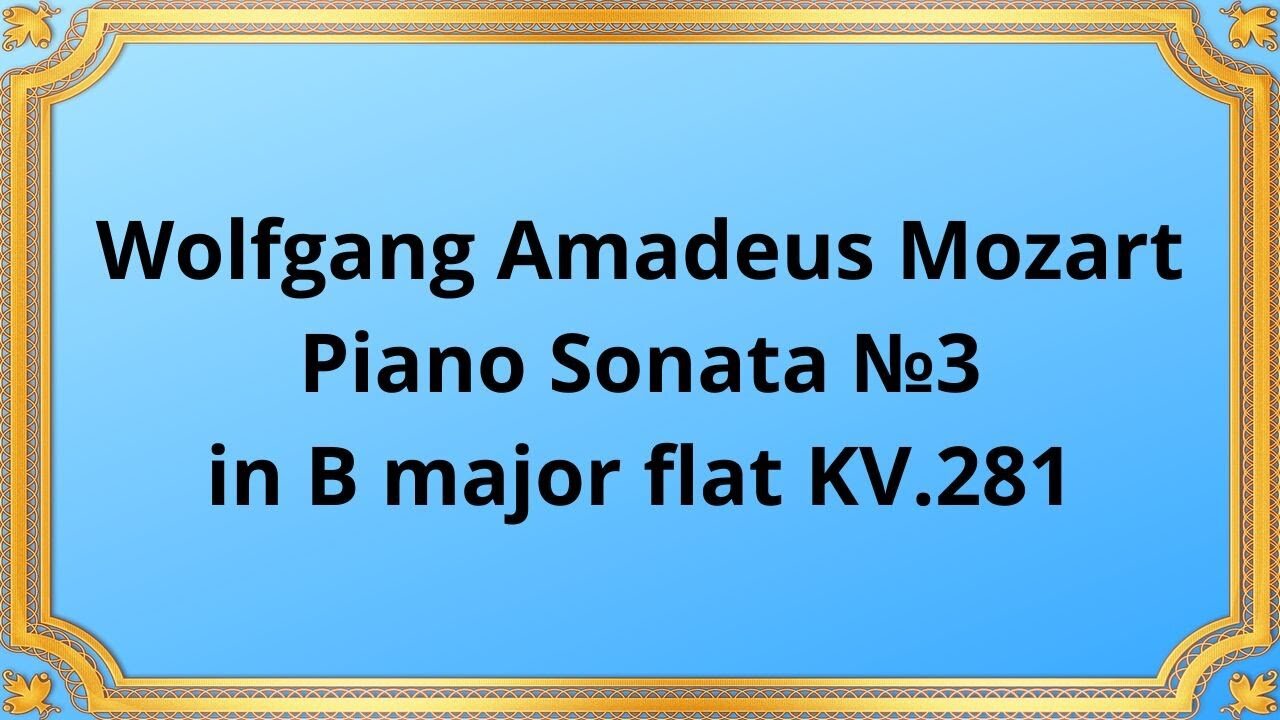Premium Only Content

Wolfgang Amadeus Mozart Piano Sonata №3 in B major flat KV.281
#chambermusic #sonata #piano #Mozart #PianoSonata #ClassicalMusic #BflatMajor #KV281 #MusicalComposition
Publication date 1951
Jacqueline Blancard, piano
Wolfgang Amadeus Mozart's Piano Sonata No. 3 in B-flat Major, KV.281, is a captivating composition that showcases the brilliance and virtuosity of the renowned composer.
To appreciate the significance of Mozart's Piano Sonata No. 3, we must understand its historical backdrop. Composed in 1774, during the Classical period, this work exemplifies the transition from the Baroque era to a more refined and expressive musical style. Mozart's contributions to this evolution are evident in the Sonata's innovative harmonic language and melodic inventiveness.
The Piano Sonata No. 3 in B-flat Major consists of three movements:
1 Allegro: The first movement opens with a lively and spirited theme, showcasing Mozart's mastery of form and structure. The development section introduces intricate melodic variations and harmonic progressions, further highlighting the composer's ability to create tension and release.
2 Andante amoroso: The second movement offers a contrasting mood, featuring a tender and introspective melody. Through delicate phrasing and expressive dynamics, Mozart evokes a sense of emotional depth and intimacy, captivating the listener with his profound musicality.
3 Rondeau: Allegro: The final movement exudes energy and playfulness, characterized by its engaging and memorable rondo theme. Mozart's skillful use of syncopation and rhythmic drive creates a sense of excitement and joy, culminating in a thrilling conclusion.
Mozart's Piano Sonata No. 3 in B-flat Major exhibits a wide range of expressive qualities that have captivated audiences for centuries. The Sonata's melodic beauty, harmonic richness, and dynamic contrasts showcase Mozart's ability to convey a myriad of emotions, from exuberance and serenity to melancholy and jubilation. The delicate interplay between the different voices within the composition further highlights Mozart's exceptional command of counterpoint and musical texture.
The enduring legacy of Mozart's Piano Sonata No. 3 is evident in its impact on subsequent generations of composers and musicians. This composition, along with Mozart's other piano sonatas, served as a source of inspiration for future pianists and composers, shaping the development of classical music. Its profound influence can still be felt today, as performers continue to interpret and celebrate the Sonata's timeless beauty.
Conclusion:
Wolfgang Amadeus Mozart's Piano Sonata No. 3 in B-flat Major, KV.281, stands as a testament to the composer's genius and his invaluable contributions to the world of music. Through its historical significance, structural elements, and expressive qualities, this composition has enthralled audiences for centuries. By exploring the intricacies of this musical work, we gain a deeper understanding of Mozart's remarkable talent and the enduring impact of his music on the classical genre.
You have the opportunity to support the channel:
https://destream.net/live/RadSiarAl/donate
https://www.buymeacoffee.com/6355radsiaral
-
 48:22
48:22
Classical music_Music Inspiration
1 month agoHector Berlioz Fantastic Symphony
701 -
 1:54:05
1:54:05
FreshandFit
2 hours agoYou Will Always Be Cheated On & This Is Why!
10.1K6 -
 LIVE
LIVE
Alex Zedra
3 hours agoLIVE! Playing CoD
968 watching -
 LIVE
LIVE
PandaSub2000
4 days agoLIVE @10:30pm ET | DONKEY KONG BANANZA!
178 watching -
 59:09
59:09
Man in America
7 hours agoOrder From CHAOS: Epstein, Israel & Ancient Bloodlines w/ Todd Callender
60.7K16 -
 LIVE
LIVE
Price of Reason
8 hours agoTrump CANCELS Gavin Newsom's High Speed Train! Can Supergirl SAVE James Gunn Superman? Zelda Casting
88 watching -
 2:48:24
2:48:24
TimcastIRL
4 hours agoBREAKING: Trump Diagnosed With Chronic Vein Disease, Covers Bruised Hands With Make Up | Timcast IRL
172K72 -
 2:44:58
2:44:58
Barry Cunningham
5 hours agoPRESIDENT TRUMP IS LEADING AMERICA TO PROSPERITY! WHAT A DAY!
49.9K32 -
 2:32:33
2:32:33
The Quartering
4 hours agoTrump Epstein "Bombshell" From Wall St. Journal Then Expedition 33!
61.2K17 -
 LIVE
LIVE
SpartakusLIVE
5 hours ago$1,000 Spartakus Gauntlet on VERDANSK for the FIRST TIME || TrulyEvil, Enzo Alder, Firefighter MDO
292 watching